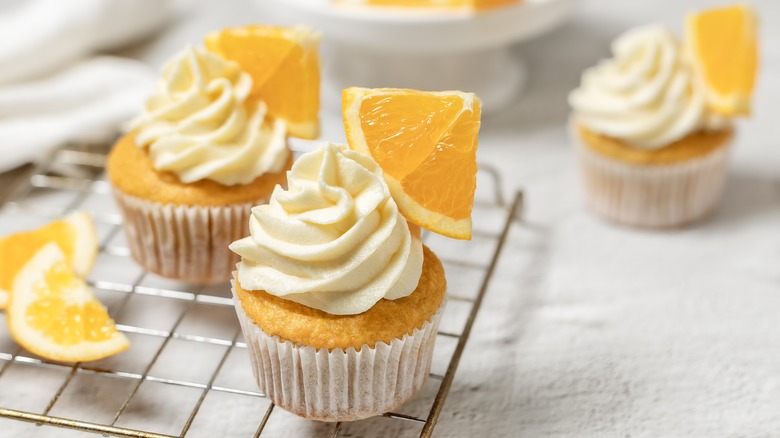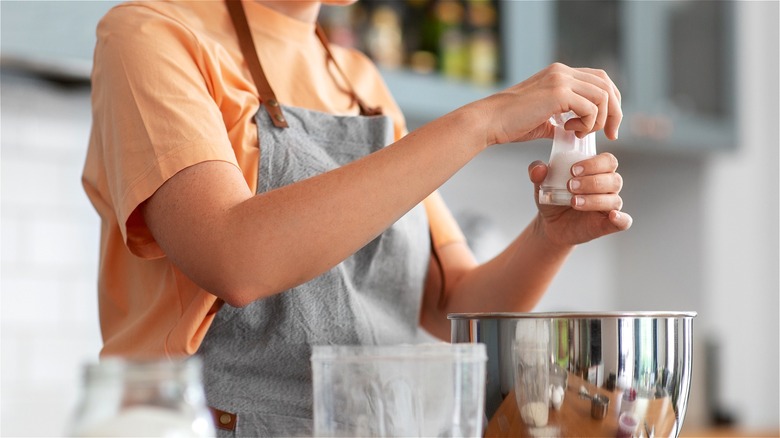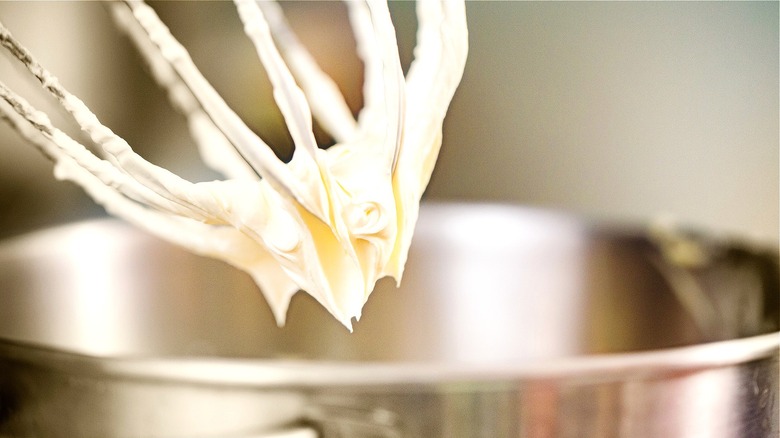The Reason You Should Add Salt To Your Buttercream Frosting
Some of our most favored desserts are covered in traditional American buttercream frosting. Who wouldn't say yes to a fresh slice of chocolate cake or citrus cupcakes, especially if they're covered with a luscious layer of whipped buttery goodness? If you enjoy baking, you're probably already privy to the standard frosting recipe that makes most baked goods stand tall above all others. Classic buttercream frosting is often composed of whipped room-temperature butter, powdered sugar, heavy cream, and vanilla.
However, depending on the desired consistency of your final product, you run the risk of making your frosting too sweet by adding too much sugar. Whether you like your buttercream extra spreadable or super sturdy, there is one tried and true way to level out the flavor of this creamy topping regardless of how much powdered sugar you use.
To award your taste buds with just the right amount of balanced flavor, consider adding a bit of salt to your buttercream frosting. Salt is a highly complex ingredient and is often added to food without thought, but something special happens when you add a bit of salt to an intrinsically sweet ingredient. According to one 2010 study, salt can enhance the flavor of sweet foods and in some cases, make sweet foods even sweeter.
Why a bit of salt is effective in upgrading your next batch of buttercream
Before trying this simple frosting hack that gives a perfect balance of flavor, you might want to know how salt specifically upgrades your favorite cake topping. First off, when you make a batch of cupcakes, followed by homemade frosting, you're expecting the primary taste to be sweet. Salt adds a contrasting flavor that provides more depth to traditional desserts by offsetting the overload of sugary flavor. Yet, surprisingly, behind our pure enjoyment of consuming sweet treats with a bit of salt, this sweet and salty connection has a lot to do with the chemicals flowing in and out of our brains.
While most of us know that salt serves as an essential mineral for the human body, sugar, on the other hand, has been known to make us happy. According to one 2007 study, sugar has been proven to release short-term jolts of dopamine, the pleasure-related neurotransmitter, throughout the body. Since our bodies crave both sugar and salt for different reasons, when they're fused, our palates and brains reach a euphoric baseline. Adding a bit of salt to your buttercream frosting not only relaxes the body but keeps things interesting for your taste buds as well.
How to add salt to homemade buttercream frosting
As you run off to your kitchen to make a new and improved batch of homemade buttercream, you may wonder how much of this savory addition is necessary to create an ideal balance of flavor. Fortunately, a lot of this decision comes down to subjective taste. Still, choosing the right type of butter will set you off in the right direction. Most of our precious recipes include the unrelenting decision to use salted or unsalted butter and buttercream frosting is no exception.
While you can create this buttery accompaniment with either variety, you may want to use unsalted butter so you can better control the amount of salt added to your final product. Depending on the brand, the range of salt in salted butter varieties varies significantly, so choosing an unsalted option will start you off with a cleaner slate.
When it comes down to physically adding this salty addition, choose a finer grain and add in only a small amount to start. Aim for well under 1 teaspoon and taste as you go. You can either add salt to your frosting once you've creamed your butter, before adding any flavor extracts and powdered sugar, or wait until your frosting is completely set before stirring in this flavor-enhancing ingredient. With just a small amount of salt, you can perfectly upgrade the taste of your buttercream and balance out the sweetness of this creamy dessert topping.


